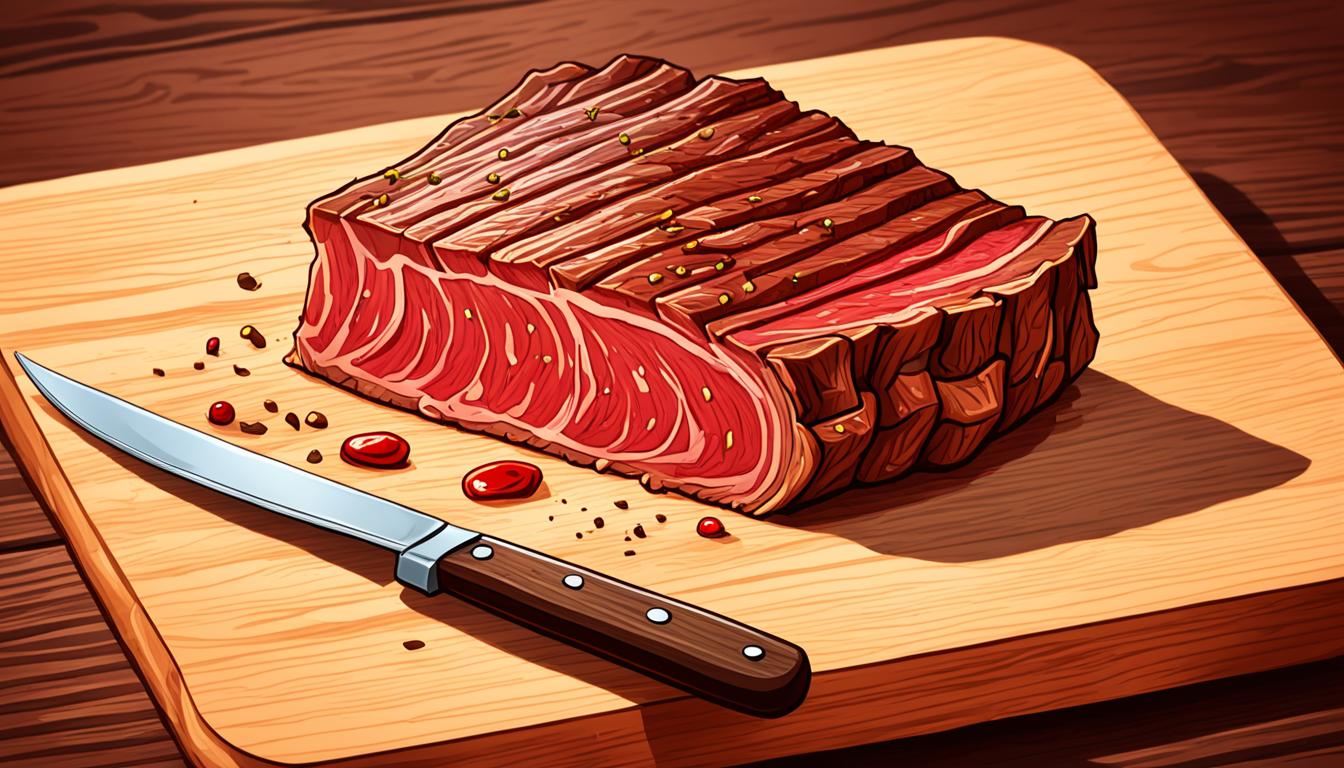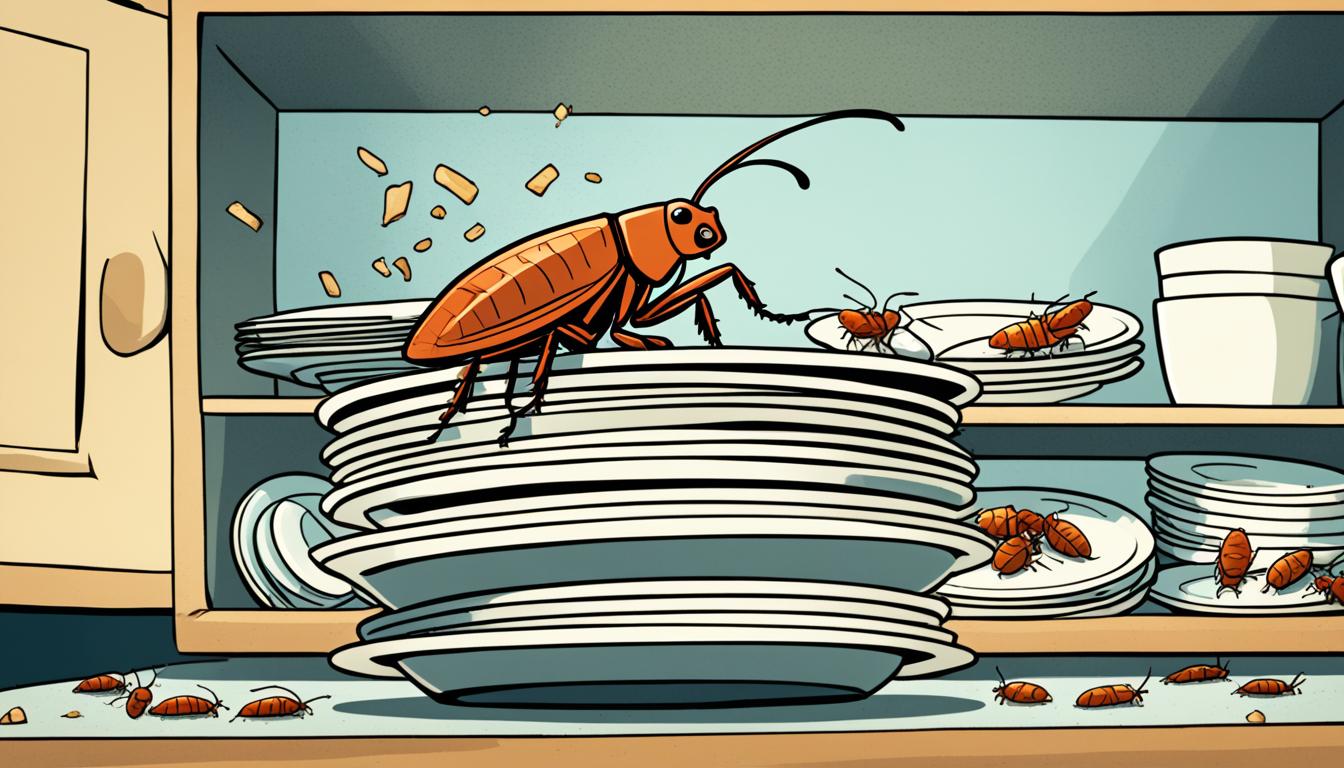Have you ever heard about kippered beef? It’s a traditional snack loved by many. People have enjoyed this delicious treat for years. Originally, it was a way for frontiersmen to keep their meat during the long winters. Now, it’s a favorite for many.
Kippered beef is special because of how it’s made. Beef slices are seasoned with salt and then smoked over wood fire. This process makes the smoked meat flavorful, tender, and thicker and juicier than beef jerky. With so many flavors available, there’s something for everyone.
Key Takeaways:
- Kippered beef is a traditional snack enjoyed by people from all walks of life.
- It originated as a method of preserving meat during winters.
- Kippered beef is thicker and juicier than beef jerky.
- It is available in a variety of exciting flavors to suit every taste bud.
- Kippered beef offers a flavorful and tender smoked meat experience.
The History of Kippered Beef
Kippered beef’s story starts with old-time frontiersmen. They salted beef slices to keep them from spoiling in winter. They then smoked the beef over wood fires. This made it tasty and helped it last during tough seasons. This technique, known as kippering, made beef tender and smoky.
Frontiersmen used kippering to make their meat last longer. It was essential for long travels or bad weather. The mix of salt and smoke didn’t just preserve the beef. It also made it taste unique.
Through the years, kippered beef became a tradition handed down through families. It was a unique way to keep meat and enjoy a special snack. Salting the meat took out moisture before smoking added flavor.
“Kippered beef was vital for frontiersmen. It helped them have food for their journeys. The salt and smoke made the meat safe and tasty.”
Soon, kippered beef wasn’t just for the frontier. Hunters, travelers, and anyone wanting a tasty treat loved it. It became known for its great taste and long shelf life.
Today, we still make kippered beef with modern methods. It’s a favorite snack because of its history and flavor. We keep the old smoking tradition alive.
Kippered Beef: A Delicacy Preserved in Tradition
Nowadays, kippered beef comes in many tastes. Artisans and food companies offer flavors like BBQ and teriyaki. There’s something for everyone.
While kippering methods have evolved, their core purpose remains. Kippered beef is great on its own, on boards, or in recipes. It offers a unique taste adventure.
The Journey of Kippered Beef: From Frontiersmen to Flavor Sensation
Kippered beef has come a long way from its early days. Its unique taste, preserved with salt and smoke, has won hearts globally. Its journey shows its lasting charm.
Kippered beef still wins fans today. Its history, craftsmanship, and taste are unmatched. Whether eaten alone or in dishes, it’s a beloved tradition.
Read on to learn about kippered beef and beef jerky. Find out in section 3 of this article.
The Difference Between Kippered Beef and Beef Jerky
Kippered beef and beef jerky are not the same. Kippered beef is thicker, which makes it juicier and more flavorful. It is salted and smoked, different from the thin and dried beef jerky. This gives kippered beef a unique taste and texture.
To understand their differences better, let’s look closely:
Kippered Beef
Kippered beef uses thick beef pieces, salted then smoked. This process boosts tenderness and taste. The meat is slowly smoked with wood, infusing deep flavors. The outcome? A rich, moist meat snack that’s tender and tasty.
Beef Jerky
Beef jerky, in contrast, uses thin beef slices. These slices are seasoned, then dried out. This makes the jerky chewy with a concentrated flavor. It’s a go-to snack for protein on the move.
Comparing the two, kippered beef is the moisture-rich option. Its thickness during smoking preserves juiciness and tenderness. This makes kippered beef’s flavor bold compared to beef jerky’s.
Kippered beef stands out as a juicier alternative to beef jerky. Its unique taste and feel provide a delightful snack. It’s great for eating on its own or adding to dishes. Kippered beef adds a smoky flavor you’ll love.
Experience both kippered beef and beef jerky to notice their unique traits. Enjoy kippered beef’s juiciness and deep flavors for an amazing snack time.

The Variety of Flavors in Kippered Beef
Kippered beef is known for its tenderness and smoky flavor. It comes in a range of exciting flavors. From Old Fashioned to the spicy Peppered, there’s a flavor for every palate. Brands even offer sweet and savory mixes, like Teriyaki, for those liking a bit of both. This makes kippered beef a versatile snack for any time.
Exploring the Taste Spectrum
There’s a wide variety of flavors in kippered beef. Fans of classic smoky taste or those preferring a kick will find a flavor to love. Each kippered beef flavor promises to satisfy your craving.
- Old Fashioned: A traditional flavor that’s a timeless favorite. Its rich smokiness and savory notes please everyone.
- Peppered: Perfect for those liking some heat. Smoky beef meets zesty pepper for a bold, flavorful snack.
- Teriyaki: A sweet and savory choice. The tangy glaze boosts the smoky beef’s flavor, making it irresistible.
“The range of flavors in kippered beef lets us cater to many palates. From classics to adventurous, there’s enjoyment for all.” – John Smith, Flavor Expert
Kippered beef offers a unique snacking experience with its diverse flavors. Enjoy it alone or in recipes, its variety sparks culinary creativity.
A Flavorful Adventure

The flavor journey of kippered beef is about discovering new tastes. Brands like Old Trapper provide a wide array of flavors. From classic tastes to creative mixes, each bite brings a burst of flavor, leaving you wanting more.
| Flavor | Description |
|---|---|
| Old Fashioned | A classic mix of rich smokiness and savory notes. |
| Peppered | Spicy pepper adds a bold kick. |
| Teriyaki | Sweet and savory glaze for a taste adventure. |
Kippered beef is a delightful snack that pleases every time. Embark on a flavorful adventure and explore the wide variety of flavors available.
Old Trapper’s Jumbo Kippered Beef Steak Snacks
Old Trapper is a familiar name in the beef jerky world. They have introduced Jumbo Kippered Beef Steak snacks. These snacks are made from top-quality American beef and smoked over real wood. This gives them the trademark wood-fired taste Old Trapper is famous for. You can find them in three flavors – Old Fashioned, Peppered, and Teriyaki. They’re jumbo-sized, perfect for snacking, and great as gifts for beef lovers. Plus, each pack has two ounces of delicious, tender beef.
The Jumbo Kippered Beef Steak snacks from Old Trapper stand out for their quality. They are made from the finest cuts of American beef. Then, they’re smoked to perfection using real wood. This process ensures a deep, authentic flavor that beef fans will love. Whether you like Old Fashioned, Peppered, or Teriyaki, there’s a flavor for everyone to enjoy.

These kippered beef steaks are big on size and flavor. Every bite is full of seasoning and expertly smoked for a delicious taste. They’re perfect for enjoying on your own or giving as gifts. If you’re looking for an impressive stocking stuffer, these are a great choice.
Looking for a tasty, smoky beef snack? Old Trapper’s Jumbo Kippered Beef Steaks are the answer. Enjoy them on their own, with your favorite beer, or in recipes. They’re sure to please with their quality and flavor. Try Old Trapper and taste the difference in every bite.
America’s Love for Beef
Americans adore beef, which is clear from what they eat. The Beef It’s What’s for Dinner website states steaks are among the favorites. Seven different steak types are in the top ten. This love for steak also shows in the popularity of steak snacks, like kippered beef. Beef is beloved for its versatility and wide appeal.
Beef is a key part of the American diet. People love it for its rich taste and tenderness. It matches well with many flavors and foods. From fancy steaks in restaurants to burgers on home grills, beef is a top pick for flavor.
“There’s nothing quite like sinking your teeth into a perfectly cooked steak. It’s a culinary experience that never fails to delight.” – Celebrity Chef
The Popularity of Steak
Steak is often the star at celebrations and special events. It suits a romantic meal or a big family gathering. Its rich flavor and juicy texture make it a hit with meat lovers.
Steak isn’t just for special days, though. It’s becoming a usual choice for everyday meals and snacks. The growing demand for steak snacks shows how much Americans enjoy this meat.
The Appeal of Steak Snacks
In our busy world, on-the-go snacks are essential. Steak snacks are a tasty, convenient choice. Kippered beef is smoked and flavorful, perfect for a quick protein boost.
Steak snacks balance convenience and taste well. They’re easy to carry, don’t need prep, and are tasty by themselves or with other foods. They’re great for a snack at work or on trips.
“I love having a pack of kippered beef in my bag for those moments when I need a quick and delicious snack. It’s the perfect fuel to keep me going throughout the day.” – Fitness Enthusiast
The Versatility of Beef
Beef’s versatility is one big reason Americans love it. There are many cuts, from tenderloin to T-bone. And there’s a way to cook steak whether you like it rare, medium, or well-done.
Beef fits into lots of dishes, from steak meals to stews and burgers. It can be grilled, roasted, stewed, or stir-fried. Cooking shows and recipes often focus on beef, showing how popular it is.

Whether enjoying a juicy steak or a tasty steak snack like kippered beef, beef’s appeal is clear. It’s loved for its flavor, tenderness, and cooking versatility. Dining out or snacking on the go, beef is a pleasure for its fans.
The Appeal of Kippered Beef Steak Snacks
Kippered beef steak snacks from Old Trapper have become quite popular. They are convenient and full of flavor. These snacks let you enjoy smoked beef quickly, without cooking. Lean beef strips are seasoned and smoked over real wood. This gives them an authentic flavor. They come in single packs or boxes of 12, perfect for any time.
Looking for something to boost your energy midday? Or need a snack full of protein for your next outing? Kippered beef steak snacks are a tasty pick. These pre-packaged snacks are great for on-the-go moments. Enjoy them on a hike, during a workout, or while relaxing at home. They’re convenient and delicious.
What really sets these snacks apart is their flavor. Spices and real wood smoke add a rich taste to the tender beef. Every bite is full of flavor, making snacking a joy. With options from bold pepper to sweet teriyaki, there’s a flavor for everyone.
“I love how convenient and tasty kippered beef steak snacks are. They are the perfect on-the-go snack!” – Jessica, a satisfied customer
Choosing the right snack means finding one that delights your taste buds. Kippered beef steak snacks blend convenience and flavor beautifully. They have a rich, smoky taste and a satisfying texture. These snacks provide a great snacking experience. Whether you like classic flavors or want to try something new, you’ll find something to enjoy.
Why Choose Kippered Beef Steak Snacks?
Kippered beef steak snacks are a top pick for many snack lovers. Here’s why:
- Convenience: They’re individually packaged, so you can easily enjoy them anywhere. There’s no need for prep or keeping them cold, making them great for busy lives.
- Flavor: A mix of spices and smoke gives these snacks a unique, delicious taste. Whether you love smoky or spicy, you’ll find a snack you like.
- Enjoyment: Snacks should be fun, and kippered beef steak snacks definitely are. The tasty beef, easy to take with you, makes snacking enjoyable.
Looking for a snack that’s both yummy and easy to take along? Try kippered beef steak snacks. Their great taste and convenience make them suited for any situation.
Here’s a snapshot of the appealing aspects of kippered beef steak snacks:
| Appealing Aspects of Kippered Beef Steak Snacks |
|---|
| Convenience |
| Flavorful |
| Enjoyable |
Kippered beef steak snacks are great for those wanting a tasty and satisfying snack. Whether you’re on the move or just enjoying some quiet time, these snacks are a hit.

The Joy of Kippered Beef and the Holidays
Kippered beef brings a smoky flavor to holiday celebrations. It’s perfect as a snack or in recipes. These steak snacks make wonderful stocking stuffers.
“Kippered beef adds a unique and savory flavor to the holiday menu, bringing joy and a delightful experience to gatherings and celebrations.”
Sharing kippered beef with loved ones makes the holidays special. It’s great on charcuterie boards or as a topping for salads. There are so many ways to enjoy it.
A Holiday Stocking Stuffer Surprise
When filling stockings, don’t overlook kippered beef steak snacks. Old Trapper offers jumbo-sized snacks that beef lovers adore. These snacks are a unique surprise for the holidays.
Each snack pack has two ounces of kippered beef in delicious flavors. Choose from Old Fashioned, Peppered, or Teriyaki. You’ll make holiday snacks exciting for everyone.
| Flavors | Quantity |
|---|---|
| Old Fashioned | 2 ounces |
| Peppered | 2 ounces |
| Teriyaki | 2 ounces |
These kippered beef surprises will bring smiles to faces. It’s a delight to see loved ones discover them.
Experience the Festive Flavor of Kippered Beef
Kippered beef is a tasty and unique holiday treat. Its smoky flavor enhances any meal. Guests will love it, whether it’s a snack or part of a dish.
This holiday, let kippered beef add excitement to your table. Discover the happiness it brings.

The Popularity of Kippered Beef as a Snack
Kippered beef is getting more popular as a snack. Its unique taste and softness make it different from other snacks like beef jerky. High-quality beef, expert smoking, and various flavors make kippered beef a tasty treat.
The distinct taste of kippered beef wins over many snack lovers. Salting and smoking the beef create a rich smoky flavor. It’s more tender and juicy than other snacks, making it delightful to eat.
Kippered beef is loved for being so versatile. You can eat it alone as a snack, or add it to recipes. It boosts the flavor of salads, sandwiches, and pasta dishes.
Kippered beef comes in many flavors. You can find classic ones like Original and Hickory Smoked, or try Sweet and Spicy. This variety lets snack fans explore and enjoy new tastes.
“Kippered beef’s unique flavor and convenience have made it a go-to snack for many. Its popularity continues to grow as more people appreciate its delicious taste and the variety of flavors it offers.”
Kippered beef is great as a quick snack, for ending hunger pangs, or as a tasty add-on to meals. Its special flavor, softness, and flexibility make it a hit with snack fans. They enjoy the depth of flavor it adds to their snack times.

Conclusion
Kippered beef is a classic snack with a long history. It started as a way to keep meat fresh. Now, it’s a favorite for many people because of its taste.
This snack is not just for holidays or quick bites. It offers a special taste that everyone loves. Kippered beef is known for its rich flavors and history. Give it a try and explore its delicious world.
Kippered beef stands out because it’s both tender and full of flavor. It comes in various tastes, including smoky and seasoned. Try this amazing snack anytime. Don’t miss out on enjoying kippered beef!
FAQ
What is kippered beef?
How did kippered beef originate?
What is the difference between kippered beef and beef jerky?
What flavors are available for kippered beef?
What are Old Trapper’s Jumbo Kippered Beef Steak snacks?
Why is beef so popular in America?
What makes kippered beef steak snacks appealing?
Why is kippered beef popular during the holidays?
Why is kippered beef a popular snack choice?
What makes kippered beef a special treat?
Can Chicken Jus be Used to Enhance the Flavor of Kippered Beef?
Yes, the understanding chicken jus essence can definitely be used to enhance the flavor of kippered beef. The rich and savory flavors of chicken jus can complement the smokiness of kippered beef, adding depth and complexity to the dish. Adding a touch of chicken jus can elevate the overall flavor profile.
Source Links
- https://oldtrapper.com/blogs/old-trapper/the-history-of-kippered-beef-steak
- https://www.provisioneronline.com/articles/110563-old-trapper-introduces-jumbo-kippered-beef-steak-snacks-for-satisfying-winter-snacking
- https://www.murdochs.com/products/home-decor/candy-snacks/snacks/jerky/old-trapper-kippered-beef-steak/










